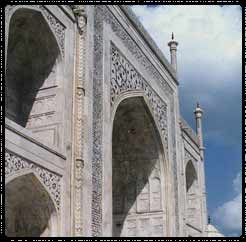Saturday, 11 January 2014
Taj Mahal Tourism
Saturday, 11 January 2014 by AnkitaKamani

The Taj Mahal (Crown Palace) is India's most famous structure,
and, perhaps the most beautiful piece of architecture in the world. Photographs
cannot truly capture the grandeur of this perfectly proportioned tomb of Mumtaz
Mahal and its creator, Shah Jahan, the fifth Mughal ruler.
Mumtaz Mahal was the second, and favorite, wife of Shah Jahan (r. 1628-1658). A Persian princess born as Arjuman Banu Begum, she was a significant influence in his life and in his policies. She died at age thirty-nine while giving birth to their fourteenth (some say thirteenth) child in 1631. The ruler went into deep mourning and much of his empire was compelled to do the same.
Almost immediately there was announced a competition for plans to construct a tomb and shrine worthy of the ruler's beloved. Numerous legends surround the selection of the architect--some even implausibly suggesting that it was a westerner from Italy or France. But although a number of names have been proposed, the architect's name is unknown. It is clear that talent from many parts of the Muslim and western worlds came together in Agra to work on the mausoleum: engineers, carvers, artists, calligraphers, architects, craftsmen of all sorts, and a variety of common laborers. It is estimated that 20,000 people worked on the tomb from 1631 to 1648. Work continued in the adjoining areas until 1653. It should be noted that the Taj Mahal is a total package of tomb, mosque, gardens, gateways and fountains.
Mumtaz Mahal was the second, and favorite, wife of Shah Jahan (r. 1628-1658). A Persian princess born as Arjuman Banu Begum, she was a significant influence in his life and in his policies. She died at age thirty-nine while giving birth to their fourteenth (some say thirteenth) child in 1631. The ruler went into deep mourning and much of his empire was compelled to do the same.
Almost immediately there was announced a competition for plans to construct a tomb and shrine worthy of the ruler's beloved. Numerous legends surround the selection of the architect--some even implausibly suggesting that it was a westerner from Italy or France. But although a number of names have been proposed, the architect's name is unknown. It is clear that talent from many parts of the Muslim and western worlds came together in Agra to work on the mausoleum: engineers, carvers, artists, calligraphers, architects, craftsmen of all sorts, and a variety of common laborers. It is estimated that 20,000 people worked on the tomb from 1631 to 1648. Work continued in the adjoining areas until 1653. It should be noted that the Taj Mahal is a total package of tomb, mosque, gardens, gateways and fountains.
Subscribe to:
Post Comments (Atom)



















0 Responses to “Taj Mahal Tourism ”
Post a Comment